Pancreatitis in Dogs and Cats

What is pancreatitis?
Pancreatitis is inflammation of the pancreas. The pancreas is a vital organ in the abdomen that is important for digestion and production of insulin. The pancreas is located near the stomach and liver.
There are two types of pancreatitis.
- Acute pancreatitis: The inflammation in the pancreas occurs suddenly. Clinical signs vary from mild to life-threatening complications that require hospitalization.
- Chronic pancreatitis: The inflammation in the pancreas is long-standing and may result in permanent damage to the pancreas leading to digestive problems (such as exocrine pancreatic insufficiency) or diabetes mellitus. Clinical signs may be mild and difficult to detect by pet owners or intermittent.
What are signs of pancreatitis?
When a dog or cat is suffering from pancreatitis, a pet owner may notice a loss of or decrease in appetite, vomiting, diarrhea, or abdominal pain. A dog may show abdominal pain by standing in a “prayer position” by stretching the body out or crying when picked up or when the abdomen is touched. Some pets may have a fever. In severe cases, the pet may have a yellow tint to the gums, whites of the eyes, or skin, which is called jaundice. Cats with pancreatitis show a more subtle set of signs, such as a reduced or absent appetite and an increase in hiding behavior.
“If your animal shows signs of pancreatitis, it is critical that a veterinarian assesses your animal quickly,” says Courtney North, a board-certified veterinary internist. “The inflammation of the pancreas can have severe consequences, even life threatening, both in the short term and long term. This is because the pancreas makes insulin which controls blood sugar levels and makes enzymes that help your animal digest food properly so that nutrients can be absorbed.”
What are causes of pancreatitis?
Causes of pancreatitis can include:
- Genetics: Some breeds are much more likely to develop pancreatitis than others, including the miniature Schnauzer, Australian terrier, Siberian husky, West Highland white terrier, bichon frise, cavalier King Charles spaniel, and poodle. Siamese cats are more likely to develop pancreatitis than other cat breeds. However, any breed of dogs or cat can develop pancreatitis.
- Diet: Dietary indiscretion, such as eating unusual food items, trash, or table scraps, or eating high-fat foods can cause pancreatitis.
- Trauma: For example, being hit by a car can cause pancreatitis.
- Medications: Some drugs, such as azathioprine, potassium bromide, L-asparaginase (a chemotherapy agent), have been linked to pancreatitis. It is not possible to predict which animals will develop pancreatitis on these medications.
- Infections: Bacterial infection of the pancreas are much less common in cats and dogs than in people. Other infections such as toxoplasmosis and calicivirus in cats and babesiosis in dogs may cause pancreatitis.
- Disease: Certain hormonal diseases, such as hypothyroidism and Cushing’s disease (i.e. hyperadrenocorticism), have been linked with pancreatitis.
Cats can have chronic pancreatitis associated with inflammation in the liver and intestines, commonly referred to as “triaditis.”
How is pancreatitis diagnosed?
After obtaining a thorough history from the pet owner, a veterinarian will require one or more of the following tests to diagnose pancreatitis:
- Full physical examination to evaluate for abdominal pain, jaundice, and other disease processes
- Routine minimum database including complete blood count, biochemistry panel, and urinalysis
- Specific blood tests, including a PLI (pancreatic lipase immunoreactivity)
- Abdominal imaging: x-rays and/or abdominal ultrasound
In rare cases, surgical biopsies
A combination of the above tests may be required to diagnose pancreatitis or another disease that can cause similar clinical signs but may require different treatment (such as an ingested foreign material).
What is the treatment for pancreatitis?
Treatment will depend on the severity of the disease and the underlying cause (if identified). There are 3 main goals of treatment for pancreatitis:
- Correct dehydration and electrolyte abnormalities
- Control signs of nausea
- Treat for abdominal pain
In mild cases, this may include a short-term diet change, oral pain relievers and anti-nausea medications. In severe cases, pets are hospitalized, and an intravenous catheter is placed to administer sterile fluids and medications. In some cases, a feeding tube is placed to provide nutrition while the pet is recovering from pancreatitis. For acute pancreatitis, a low-fat diet for dogs and highly digestible diets for cats is recommended for 1-4 weeks (depending on severity). The veterinarian will also discuss prevention of another bout of pancreatitis, which may include lifelong changes including diet, supplements or medications.
What is the outcome of treatment?
Some cases of pancreatitis will heal completely, while others may show damage that accumulates over time, particularly if your pet has had multiple episodes of pancreatitis or severe pancreatitis. In exceptionally severe cases, long-term diseases such as chronic kidney disease, diabetes mellitus or exocrine pancreatic insufficiency (i.e. EPI) may develop and may require lifelong treatment. Even with excellent treatment, severe cases of pancreatitis can result in death. Your veterinarian’s goals are to help you, and your pet, do well during an episode of pancreatitis and also to help prevent or minimize future occurrences.
Edited by:
Stacie Summers, DVM, DACVIM (SAIM)
April, 2020
Articles by Specialty
- Cardiology (19)
- Large Animal Internal Medicine (23)
- Neurology (17)
- Oncology (21)
- Small Animal Internal Medicine (29)
Articles by Animal
- Cats (35)
- Dogs (52)
- Farm Animals (5)
- Horses (12)
